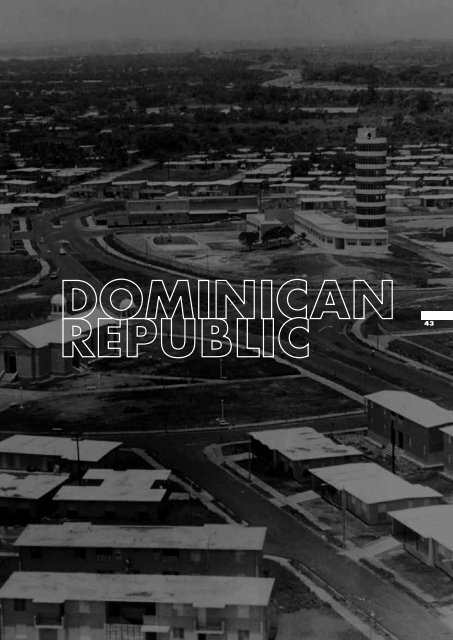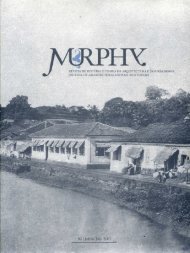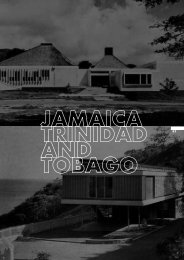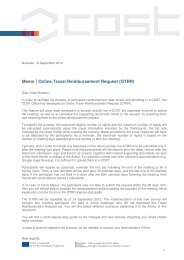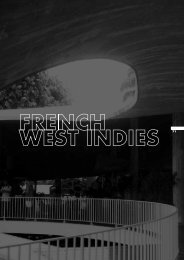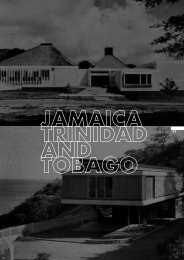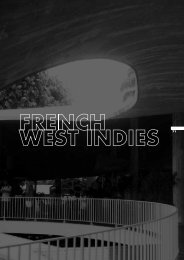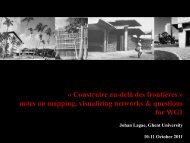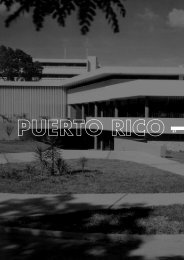Santo Domingo, Modernity and Dictatorship
Santo Domingo, Modernity and Dictatorship
Santo Domingo, Modernity and Dictatorship
You also want an ePaper? Increase the reach of your titles
YUMPU automatically turns print PDFs into web optimized ePapers that Google loves.
<strong>Santo</strong> <strong>Domingo</strong>,<br />
<strong>Modernity</strong><br />
<strong>and</strong> <strong>Dictatorship</strong><br />
OMAR RANCIER<br />
In the early twentieth century, <strong>Santo</strong> <strong>Domingo</strong> was a small village.<br />
When it burst its original limits of the colonial wall <strong>and</strong> of the villages<br />
of San Carlos to the North <strong>and</strong> of Pajarito on the east bank of the Ozama<br />
River, those peripheral settlements became part of the Republic’s capital.<br />
AT THAT TIME, the modern movement was underdeveloped<br />
in <strong>Santo</strong> <strong>Domingo</strong>. Meanwhile, the European masters were<br />
carrying out their works <strong>and</strong> the bauhauslers, who had<br />
fled the nazis <strong>and</strong> settled in the United States, participated<br />
in a process by which the total social content of modernity<br />
was lost, according to Colin Rowe. 1<br />
After nine years of the Trujillo nightmare the city changed<br />
its name to Ciudad Trujillo. This change was marked by<br />
the first consistently modern structure, the Copello<br />
building, erected in the emblematic Calle El Conde in<br />
1939. Thus, modernity came to <strong>Santo</strong> <strong>Domingo</strong> during<br />
the m<strong>and</strong>ate of Rafael Leonidas Trujillo Molina, the<br />
dictator who held Dominican society in his fist for three<br />
decades from 1930 to 1961. In his own person Trujillo<br />
assumed the role which the amorphous Dominican<br />
bourgeoisie did not take on, a pattern that became the<br />
usual strategy of other contemporary Latin American<br />
dictators: Pérez Jiménez in Venezuela, Machado <strong>and</strong><br />
Batista in Cuba, <strong>and</strong> Perón in Argentina. <strong>Santo</strong> <strong>Domingo</strong><br />
initiated its major modern urban projects, dividing them<br />
into two major divisions: on the one h<strong>and</strong>, public housing<br />
projects, such as the Barrios Obreros (Henry Gazón), 2 the<br />
Barrio of Maria Auziladora to the north of the city <strong>and</strong> the<br />
Barrio of Los Mina (Ramón Báez López-Penha <strong>and</strong> Pablo<br />
Mella) in the center, <strong>and</strong> on the other h<strong>and</strong>, institutional<br />
projects like the University City (José Antonio Caro<br />
Alvarez, Humberto Ruiz Castillo <strong>and</strong> André Dunoyer<br />
de Segonzac). The Fair of Peace <strong>and</strong> Fraternity of the<br />
Free World (Guillermo González), Caro’s Medical<br />
School <strong>and</strong> González’s Governmental Palace of the<br />
Federal District are emblematic works of the Dominican<br />
modern movement. Other relevant urban works are the<br />
Malecón, an enormous urban space more than twenty<br />
kilometers long, also known as the George Washington,<br />
which preserved the city’s seascape, Máximo Gómez<br />
Avenue <strong>and</strong> Fabré Gefrard Avenue <strong>and</strong> other<br />
thoroughfares, which created the first north-south axes of<br />
<strong>Santo</strong> <strong>Domingo</strong>. All these works were directed by<br />
engineer Ramón Báez López-Penha.<br />
ONLY IN THE MID 1950s, with the Regulating Plan of<br />
Ciudad Trujillo drawn up by Ramón Vargas Mera, does<br />
a vision of a modern city for <strong>Santo</strong> <strong>Domingo</strong> appear. This<br />
is in spite of two urban plans for the city, more<br />
neoclassical than modern, one of which was conceived<br />
by Guido D’Aless<strong>and</strong>ro <strong>and</strong> José Antonio Caro in 1937, 3<br />
<strong>and</strong> the other by José Ramón Lopez-Penha (1938).<br />
Virgilio Vercelloni called Lopez-Penha’s plan ‘comical<br />
<strong>and</strong> banal.’ 4 <strong>Modernity</strong> is impeded by the need to satisfy<br />
the central <strong>and</strong> hegemonic powers. So, on the one h<strong>and</strong>,<br />
projects are executed which attempt to make the city<br />
more efficient <strong>and</strong> which fulfill the requirements of<br />
motorized transportation, <strong>and</strong> on the other h<strong>and</strong>, which<br />
render the city a medium to promote the dictatorship’s<br />
power <strong>and</strong> presence.<br />
THE CREATION of a formal repertory 5 made of a full<br />
neoclassical catalogue is conceived by Henry Gazón. 6 It<br />
extends the regime’s power, from the capital to the distant<br />
<strong>and</strong> troubled frontier with Haiti.<br />
PERHAPS one of the most interesting aspects of the<br />
transition to modernity in the Dominican Republic under<br />
Trujillo’s rule is the use of a double code. This enabled<br />
53<br />
Docomomo N°33<br />
September 2005
Fig. 2. José Antonio Caro, José Ramón Báez et al, aerial photography of the campus of <strong>Santo</strong> <strong>Domingo</strong> University, circa 1945<br />
© photo Stopelman<br />
54<br />
the regime to appear as a modern, even democratic,<br />
government in its hotels, schools <strong>and</strong> hospitals, all of<br />
which are conceived <strong>and</strong> built in a mature modern idiom.<br />
On the other h<strong>and</strong>, buildings which house organs of<br />
social control, such as police detachments, court houses,<br />
fortresses <strong>and</strong> other government buildings, have an<br />
almost fascist look. Conforming to the semantics of the<br />
regime, they are called ‘palaces.’ 7<br />
THIS DOUBLE CODE also appeared in the works of some<br />
the main Dominican architects of the period, namely<br />
Guillermo González <strong>and</strong> José Antonio Caro. In his housing<br />
projects, González worked within a traditional idiom, <strong>and</strong><br />
in his institutional buildings he worked within a modern<br />
idiom, stark <strong>and</strong> of colossal scale. In his modern idiom, he<br />
was equally skillful in rotation (Hotel Jaragua) <strong>and</strong> frontalness<br />
(the Palace of the City Government of the Federal District).<br />
In his Secretariat of Education <strong>and</strong> his Central Bank, Caro<br />
does not impose himself, but rather minimizes his own<br />
personality, which results in a neoclassicism far from the<br />
modern plasticity of his Medical School of the University<br />
of <strong>Santo</strong> <strong>Domingo</strong> or from the Bauhaus rationality of the<br />
Engineering <strong>and</strong> Architecture School. 8<br />
THIS STYLISTIC INCONSISTENCY of modern architects<br />
is not exclusive to the Dominican Republic. In the preface<br />
to her fine book Malaussena: Arquitectura Academica en<br />
la Venezuela Moderna, Sylvia Hernández de Lasala,<br />
writes of the Venezuelan Luis Malaussena: “A worrying<br />
<strong>and</strong> seductive question arises which needs examination:<br />
how can a work like the headquarters of the Secretariat<br />
of the Presidency of the Republic, known as the White<br />
Palace, <strong>and</strong> of a neoclassic appearance, have been<br />
conceived at the same time as the Guaicamacuto Hotel,<br />
today the Marcuto Sheraton, <strong>and</strong> the Maracay Hotel,<br />
which are both examples of the purest international style?” 9<br />
Ever since Haussmann in the nineteenth century laid out<br />
long perspectives which were incidently also useful for<br />
controlling rebellions with grape-shot, almost all dictators<br />
have preferred imposing projects <strong>and</strong> gr<strong>and</strong> avenues in<br />
their urban plans. 10 We see this in Caracas in the<br />
monumental works of Malaussena <strong>and</strong> in Havana in the<br />
gr<strong>and</strong> avenues designed by Forestier. In <strong>Santo</strong> <strong>Domingo</strong>,<br />
during the consolidation of modernity which occurred<br />
during the Trujillo period, there was no structured will<br />
expressed in a master plan. Rather, what occurred was a<br />
series of unstructured works which fulfilled very defined<br />
needs but which in the end orchestrated a proposal for a<br />
modern city.<br />
The engineer Ramón Báez López-Penha wrote about<br />
the urban regulations enacted to remedy the effects<br />
of the 1930 hurricane San Zenon: “let us continue<br />
assembling housing developments mechanically <strong>and</strong><br />
uncreatively without any plan or specific goal so that<br />
we can continue to lack what we lack today, that is,<br />
clear <strong>and</strong> precise plans to guide us.” 11<br />
The direction of Máximo Gómez Avenue, also planned<br />
by Báez, demonstrated this lack of structural vision<br />
Docomomo N°33<br />
September 2005
when the construction of General Andrews airport<br />
mutilated this avenue’s north-south line. This axis was<br />
completed only in the final years of the dictatorship<br />
when the airport was moved to Cabo Caucedo, its<br />
present location, thirty kilometers east of the city. This<br />
group of traffic arteries was completed with a project<br />
which became the paradigm of the Trujillo era’s<br />
architecture <strong>and</strong> urbanism: the Fair of Peace <strong>and</strong><br />
Fraternity of the Free World, completed in record time in<br />
1955 to celebrate the twenty-fifth anniversary of the<br />
regime. It was designed by Guillermo González Sánchez<br />
<strong>and</strong> was influenced by the EUR 42 <strong>and</strong> the University of<br />
Rome. 12 Caro’s plan for the University of <strong>Santo</strong> <strong>Domingo</strong><br />
(in collaboration with Humberto Ruiz <strong>and</strong> the French<br />
designer of the Basilica of Higuey, Dunoyer de Segonzac)<br />
dates from this period.<br />
IT SHOULD BE POINTED OUT that Caro’s urban schemes<br />
for the University <strong>and</strong> González’s for the Fair recognize<br />
the postulates of modern urbanism. They are particularly<br />
axial, defined by the two main axes with their<br />
monumental end points, the Alma Mater building at the<br />
University <strong>and</strong> the Plaza of the Nations (better known as<br />
‘the little ball of the world’) at the fair. The modernity of<br />
Fig. 3. Guillermo González et al, aerial photography of the Fair of Peace <strong>and</strong> Fraternity of the Free World, <strong>Santo</strong> <strong>Domingo</strong>, 1955<br />
55<br />
© photo Stopelman<br />
Fig. 4. Rafael Tomás Hernández, urban development<br />
of the barrio de Honduras, <strong>Santo</strong> <strong>Domingo</strong>, 1966<br />
Fig. 5. Rafael Tomás Hernández, urban development<br />
of the barrio del Hoyo de Chulín, <strong>Santo</strong> <strong>Domingo</strong>, 1988<br />
Docomomo N°33<br />
September 2005
56<br />
these ensembles is seen in the design of their buildings<br />
<strong>and</strong> in their urban installations, but not in their conception<br />
of space or their management of vehicular traffic.<br />
Trujillo compromised Dominican modernity when he<br />
commissioned a catalogue of works representing the<br />
regime throughout the country. Gázon Bona created a<br />
‘Trujillista’ typology of Dominican architecture in a series<br />
of projects in San Cristobal, where he built hotels,<br />
housing projects <strong>and</strong> schools; in Santiago with his<br />
Monument to Peace of Trujillo <strong>and</strong> dozens of ‘palaces;’<br />
<strong>and</strong> in the frontier region where he designed hotels,<br />
barracks, municipal government buildings, law courts<br />
<strong>and</strong> branch offices of the Dominican party.<br />
<strong>Santo</strong> <strong>Domingo</strong> never had a structured vision of a modern<br />
city (or to be exact, of any kind of city), unlike Cuba<br />
during Machado’s dictatorship, for whom Forestier<br />
worked, as he also did in Argentina. 13 In reality, the city’s<br />
urban project appears to be only the sum of independent<br />
<strong>and</strong> punctual works, linked to the city to optimize <strong>and</strong><br />
adapt it to the new times without touching to the historical<br />
center, as José Lluís Sert proposed for Havana in 1959. 14<br />
The architect Ramón Vargas Mera, author of the<br />
Regulating Plan for <strong>Santo</strong> <strong>Domingo</strong> in 1956 recognized<br />
a bit of this when he wrote: “Demolishing the historical<br />
center <strong>and</strong> building towers in its place is not what is<br />
proposed. The center is to be respected, with its<br />
architectural <strong>and</strong> urban values.” 15<br />
Vargas Mera was the only one to dem<strong>and</strong> a vision of a<br />
modern city for <strong>Santo</strong> <strong>Domingo</strong>. Nevertheless, his vision<br />
questioned orthodox modern urbanism, as he noted<br />
when writing about the plan: “The system of zoning<br />
according to function, central to the CIAM <strong>and</strong> the Athens<br />
Charter, is to be substituted by a system of mixed zoning<br />
in which the predominant activity will stimulate the<br />
character of the zone <strong>and</strong> secondary activities will<br />
complement the zone’s use.” 16<br />
The fact that Vargas Mera’s plan was rejected, once it<br />
conflicted with the regime’s political interests, reaffirmed<br />
the refusal of political will to conceive of the city as an<br />
integrated whole. This attitude continues today.<br />
AFTER THE FALL of the Trujillo regime in 1961, <strong>Santo</strong><br />
<strong>Domingo</strong> recovered its name <strong>and</strong> became an open city<br />
which continues to enforce its vision of modernity.<br />
However, it has still not drawn up a master plan, <strong>and</strong> we<br />
continue to hope to see it converted into a better city.<br />
Although modernism was practiced during the Trujillo<br />
era, a modern city, participatory, functional <strong>and</strong><br />
democratic, remains to be constructed. Joaquín Balaguer,<br />
elected president with the support of the invading troops<br />
of the Organization of American States, was more<br />
interested in the colonial city, bad housing <strong>and</strong> large<br />
parks. Nor have subsequent governments really involved<br />
themselves in the city. And so, after five centuries, <strong>Santo</strong><br />
<strong>Domingo</strong>, lying by the Ozama River, still awaits a<br />
contemporary identity, which has yet to arrive.<br />
OMAR RANCIER, architect, graduated cum laude from the University<br />
Autónoma of <strong>Santo</strong> <strong>Domingo</strong> in 1979. President <strong>and</strong> founder of the<br />
group Neuvarquitectura, organizer of architectural biennials in <strong>Santo</strong><br />
<strong>Domingo</strong>, author of numerous articles <strong>and</strong> essays in <strong>Santo</strong> <strong>Domingo</strong>'s<br />
major specialist journals, professor at the school of architecture at<br />
the University Pedro Henríquez Ureña (UNPHU). Omar Rancier was also<br />
director of the Faculty of Architecture at the University Iberoamericana<br />
(UNIBE).<br />
Translated by Jon Kite<br />
NOTES<br />
1 Colin Rowe, Fred Koeter, Ciudad Collage (Barcelona: GG, 1981), 34.<br />
2 Eugenio Pérez Montas, La Ciudad del Ozama (Barcelona: Patronato<br />
de la Ciudad Colonial de <strong>Santo</strong> <strong>Domingo</strong> & Centro de Altos Estudios<br />
Humanísticos y del Idioma Español, 1999), 284.<br />
3 Ibid., 283. Taken from J. Chez Checo, El Palacio Nacional de<br />
la República Dominicana: 50 Años de historia y arquitectura (<strong>Santo</strong><br />
<strong>Domingo</strong>: Secretaria Administrativa de la Presidencia, 1997).<br />
4 Virgilio Vercelloni, Atlas Histórcio de <strong>Santo</strong> <strong>Domingo</strong> (Milan:<br />
Cosmopoli, 1991).<br />
5 Architect Ramón Martinez, “El Significado de la Arquitectura de<br />
la Era de Trujillo,” paper presented at Arquitectura Contemporanea<br />
en la República Dominicana, organized by the Grupo<br />
Nuevarquitectura (Casa de Teatro, September 4–6, 1981).<br />
6 “In its time, by which it was inspired, the typical neoclassicism was<br />
born, which was extremely characterized by its lines. These limpid<br />
creations resemble a past overflowing with tradition <strong>and</strong> nationality.”<br />
Henry Gazón Bona, La Arquitectura Dominicana en la Era de Trujillo<br />
(Collection Henry Gazón Bona, 1949), 1.<br />
7 Architect Ramón Martinez, “El Significado de la Arquitectura de<br />
la Era de Trujillo,” paper presented at Arquitectura Contemporanea<br />
en la República Dominicana, organized by the Grupo<br />
Nuevarquitectura (Casa de Teatro, September 4–6, 1981).<br />
8 Omar Rancier, “Versatilidad estilistica en la Arquitectura<br />
de Guillermo González,” Nuevarquitectura 43, El Siglo (February 23,<br />
1990): 6B.<br />
9 Silvia Hernández de Lasala, Malaussena: Arquitectura Academica<br />
en la Venezuela Moderna (Caracas: Editorial ExLibris, 1990), 20.<br />
10 Leonardo Benevolo, Historia de la Arquitectura Moderna<br />
(Barcelona: Gustavo Gili, 1982), 100.<br />
11 Engineer José R. Báez López-Penha, “<strong>Santo</strong> <strong>Domingo</strong>:<br />
Su Fundación y Crecimiento,” paper presented at the round table<br />
on urban planning (National University Pedro Henriquez Ureña,<br />
July 6–8, 1972). Codia 26, May/August 1971.<br />
12 Gustavo Luis Moré, “Guillermo González: A los 82 años de<br />
su nacimiento,” Hoja de Arquitectura 26, “El Nuevo Diario”<br />
(November 1, 1982).<br />
13 Jean-François Lejeune, “The City as L<strong>and</strong>scape: Jean Claude<br />
Nicolas Forestier <strong>and</strong> the Great Urban Works of Havana,<br />
1925–1930,” The Journal of Decorative <strong>and</strong> Propag<strong>and</strong>a Arts 22<br />
(Cuba, 1996): 165.<br />
14 Mario Coyula, “Influencias Cruzadas Cuba/EUU en el medio<br />
construido: Carril dos, o autopista en dos sentidos?,” Archivos<br />
de Arquitectura Antillana, Year 5, No. 10 (June 2000): 121.<br />
15 Ramón Vargas Mera, “Tendencias Urbanisticas in America Latina<br />
y el Caribe: La Situacion a Finales del Siglo XX,” Amigo del Hogar<br />
(<strong>Santo</strong> <strong>Domingo</strong>, 2004): 73.<br />
16 Ibid.<br />
Docomomo N°33<br />
September 2005


